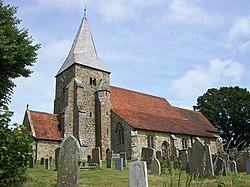Burwash
| Burwash | |
| Sussex | |
|---|---|
 Burwash High Street | |
| Location | |
| Grid reference: | TQ675247 |
| Location: | 50°59’52"N, -0°23’11"E |
| Data | |
| Population: | 2,713 (2011) |
| Post town: | Etchingham |
| Postcode: | TN19 |
| Dialling code: | 01435 |
| Local Government | |
| Council: | Rother |
| Parliamentary constituency: |
Bexhill and Battle |
Burwash, archaically known as Burghersh, is a rural village in Sussex. Situated in the High Weald some 15 miles inland from the port of Hastings, and five miles south-west of Hurst Green, on the A265 road, and on the River Dudwell, a tributary of the River Rother. In an area steeped in history, some nine miles to the south-east lies Battle Abbey and eight miles to the east is Bodiam Castle.
The village's main claim to fame is that for half of his life Rudyard Kipling (1865–1936) lived in the village at Bateman's. Kipling used the house's setting and the wider local area as the setting for many of his stories in Puck of Pook's Hill (1906) and the sequel Rewards and Fairies (1910), and there is a Kipling room at "The Bear" public house, one of two pubs located along Burwash High Street. Rudyard's son, John Kipling, died during the First World War and is named on the village war memorial at the end of Bell Alley Lane. He was named after Rudyard's father, the artist John Lockwood Kipling, (1837–1911), who provided illustrations for The Jungle Book. A complete collection of Kipling's works, including Just So Stories, Rewards and Fairies, The Man Who Would Be King and Kim, was published as the "Burwash Edition" (1941).
History
The village developed as a trading place when King Henry III authorised a weekly market in 1252. He also allowed a three-day fair in May.[1] Smuggling took place in the 18th and 19th centuries, and several smugglers' graves can still be seen in the churchyard of St Bartholomew's.
The main road through Burwash, today's A265, was improved in the 18th and 19th centuries after it came under the administration of the Ringmer and Hurst Green turnpike trust. The trust was formed in 1765 after fifteen petitions were presented to parliament on 25 December 1764 calling for the road to be turnpiked because it was stated to be "in many places impassable for wheeled conveyances in winter". The highway covered by the trust extended for 23 miles across the east of the county from Ringmer, near Lewes, in the west, to Hurst Green in the east, where it met the principal turnpike road from London to Hastings (today's A21). The first section of road to be turnpiked ran from Hurst Green to Burwash; the rest followed three years later. A number of toll gates and bars were erected in the Burwash area on the principal highway and side roads. Although the trust repaired and improved the existing parish roads it was not until around 1830 that entirely new sections of main road were built, including one at Burwash Common. In a parliamentary return of 1840 the trust reported the roads it administered to be in good condition, with the exception of a short branch running from Burwash Common towards Stonegate. The trust was wound up in November 1864.[2]
The road through Burwash was a notorious spot for highwaymen.
Burwash was one of the villages involved in the Wealden iron industry, and there was a forge located at Burwash Weald, close to the site of the historic "Wheel" public house.[3]
A traditional marriage-rhyme includes the archaic pronunciation of the name: "To love and to cherish, / From Battle to Berrish, / And round about Robertsbridge home ..." ("Burrish" is a variant pronunciation mentioned in 1933).[4]
Landmarks

St Bartholomew's Church is a Grade II* listed building.
The High Street is designated a conservation area, and the buildings along the High Street have been given listed building status, including a garden wall.[5]
Kipling's mansion, Bateman's, a fine example of Jacobean architecture formerly owned by Rudyard Kipling, is now a National Trust property, open to the public. It can be found just outside the main village on the Burwash Weald and Common side, and is set within 33 acres of the Sussex Weald, and includes a working watermill and millpond, which connects to the River Dudwell. The location was used while shooting the film My Boy Jack (2007), starring Daniel Radcliffe. A bronze statue of Kipling by the local sculptor Victoria Atkinson was installed in the High Street in 2019.[6]
There is a Site of Special Scientific Interest within the parish—Dallington Forest, an area of ancient woodland. Its interest lies in a nationally rare habitat as a result of a steep-sided stream flowing through the site.[7]
Outside links
| ("Wikimedia Commons" has material about Burwash) |
References
- ↑ "History". Burwash Parish Council. https://burwashparish.org.uk/history/.
- ↑ "East Sussex Turnpikes of the High Weald". Sussex Industrial History 43: 33–36. 2013.
- ↑ Mees, K. 2010 Mees, Kate (January 2010). "Documentary and literary evidence relating to Burwash Forge and Wynhamford Mill, East Sussex". Wealden Iron, 2Nd Series 30: 10-29 (WIRG). https://www.academia.edu/2516481. Retrieved 7 April 2012.
- ↑ Egerton, John Coker (1933) Sussex Folk and Sussex Ways; 4th ed. London: Methuen; p. vii
- ↑ National Heritage List 1044042: Garden wall of Denes House to the east of the house (Grade II listing)
- ↑ "Sussex World: Statue of Rudyard Kipling unveiled in Burwash, 19 February 2019". 19 February 2019. https://www.sussexexpress.co.uk/news/statue-of-rudyard-kipling-unveiled-in-burwash-103837.
- ↑ SSSI listing and designation for Dallington Forest
- Egerton, John Coker (1933) "Lecture on the history of the parish of Burwash; delivered March 6, 1871 and March 6, 1876"; in Sussex Folk and Sussex Ways; 4th ed. London: Methuen; pp. 131–62 (1st ed. Chatto & Windus, 1892)
- --do.-- (1992) Victorian Village: the diaries of the Reverend J. C. Egerton of Burwash, 1857-1888; edited by Roger Wells. Stroud: Alan Sutton ISBN 0750902876